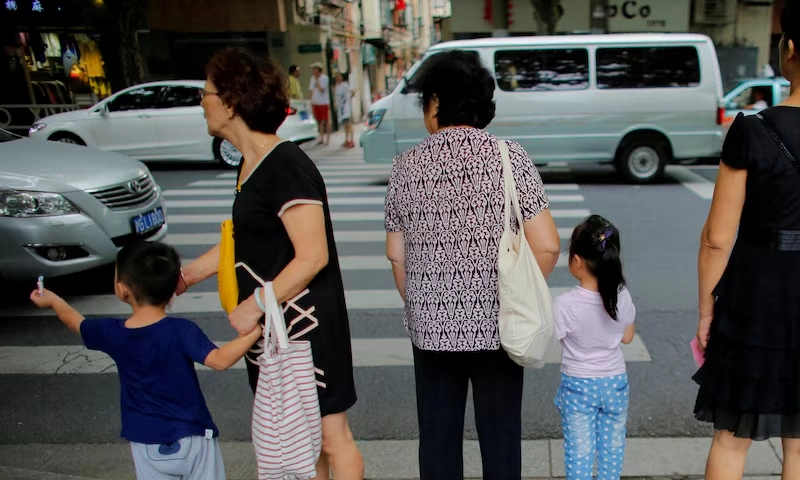- Web Desk
- Today

Childcare subsidies as China deals with one-child policy fallout

BEINJING: China had implemented the one-child policy ruthlessly. It managed to control birth rate and happily surrendered the position of most-populace state in the world to India. But the decades of strict policy produced the unwanted demographic crisis, with a nosediving birth rate, declining population and higher share of aged people. So what now? The answer is childcare subsidies
Meanwhile, the demographic crisis is also a serious threat to the sustainability of Chinese economy. Just check the pension issue.
Read more: China raises retirement age as population ages
According to an AFP report, China’s government will offer subsidies to parents to the tune of $500 per child under the age of three per year, Beijing’s state media said Monday.
The nationwide subsidies apply retroactively from January 1, Beijing’s state broadcaster CCTV said, citing a decision by the ruling Communist Party and the State Council, China’s cabinet.
“This is a major nationwide policy aimed at improving public wellbeing,” CCTV said.
“It provides direct cash subsidies to families across the country, helping to reduce the burden of raising children,” it added.
There were just 9.54 million births in China last year, half the number than in 2016, the year it ended its one-child policy, which was in place for more than three decades.
So it is not a surprise that the population declined by 1.39 million last year, and China lost its crown as the world’s most populous country to India in 2023.
Marriage rates are also at record low levels, with many young couples put off having babies by high child-rearing costs and career concerns.
‘VERY COSTLY’
Parents in Beijing welcomed the fresh subsidies, but said more needed to be offered for them to consider having extra children.
“For young couples who just got married and already have a baby, it might actually encourage them to consider having a second child,” Wang Xue, a mother to a nine-year-old son, told AFP.
“After all, the subsidy does help ease their burdens… and also offers some psychological comfort,” Wang said.
But she said the new measures would not be enough to convince her to have a second child.
“Having one child is manageable, but if I had two, I might feel a bit of (financial) pressure,” the 36-year-old told AFP.
Zhang Wei, a 34-year-old father of a daughter and son, said the new subsidies were “a good start” because raising children was getting more expensive.
“Compared to our generation, the costs have definitely increased exponentially,” he said.
‘GROUNDWORK FOR THE FUTURE’
While analysts said the subsidies were a step in the right direction, they warned that the new measures alone would not reverse China’s population decline, nor boost its domestic spending slump.
“It is encouraging that the government finally moved to use fiscal subsidies to boost fertility,” said Zhiwei Zhang, president and chief economist at Pinpoint Asset Management.
It also showed the government recognised the “serious challenge” that low fertility rates posed for the economy, Zhang added.
Zichun Huang, China economist at Capital Economics, said the policy marked a “major milestone” in terms of direct handouts to households and could lay the groundwork for more fiscal transfers in the future.
But he said the sums were too small to have a “near-term impact on the birth rate or consumption”.
Many local governments have already rolled out subsidies to encourage childbirth.
Read more: As birthrate falls, Erdogan declares ‘decade of the family’
In March, Hohhot, the capital of China’s northern Inner Mongolia region, began offering residents up to 100,000 yuan ($14,000) per newborn for couples with three or more children, while first and second children will be eligible for 10,000 and 50,000 yuan subsidies.
In Shenyang, in northeastern Liaoning province, local authorities give families who have a third child 500 yuan per month until the child turns three.
More than 20 provincial-level administrations in the country now offer childcare subsidies, according to official data.
Premier Li Qiang vowed to provide childcare subsidies during the government’s annual work report in March.
China’s shrinking population is also ageing fast, sparking worries about the future of the country’s pension system.
There were nearly 310 million people aged 60 and over in 2024.
PAST INITIATIVES
Given that the low birthrate and the young people, especially women, are avoiding marriage, there has been efforts at the local level in the past to attract the young Chinese to produce babies.
Meanwhile, there is another dimension. Chinese women are challenging the social norms as China progresses rapidly towards an industrialized society from an agrarian one.
In one of such instances, family planning authorities in the historic Chinese city of Xian texted residents in Nov 2023, wishing them “sweet love, marriage and childbirth”, and to create “good fertility”.
But the higher cost of living means there isn’t much attraction in “awareness campaigns”. China is one of the most expensive countries when it comes to raising a child.
That’s why Beijing has decided now to go for a nationwide solution of childcare subsidies.






